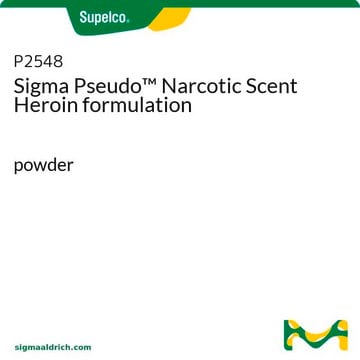Wichtige Dokumente
P-007
PCP (Phencyclidin) -Lösung
1.0 mg/mL in methanol, ampule of 1 mL, certified reference material, Cerilliant®
Synonym(e):
Phencyclidine
Größe auswählen
About This Item
Empfohlene Produkte
Qualität
certified reference material
Qualitätsniveau
Form
liquid
Leistungsmerkmale
Snap-N-Spike®/Snap-N-Shoot®
Verpackung
ampule of 1 mL
Hersteller/Markenname
Cerilliant®
drug control
Narcotic Licence Schedule A (Switzerland); psicótropo (Spain); Decreto Lei 15/93: Tabela IIA (Portugal)
Konzentration
1.0 mg/mL in methanol
Methode(n)
gas chromatography (GC): suitable
liquid chromatography (LC): suitable
Anwendung(en)
forensics and toxicology
Format
single component solution
Lagertemp.
2-8°C
SMILES String
N3(CCCCC3)C2(CCCCC2)c1ccccc1
InChI
1S/C17H25N/c1-4-10-16(11-5-1)17(12-6-2-7-13-17)18-14-8-3-9-15-18/h1,4-5,10-11H,2-3,6-9,12-15H2
InChIKey
JTJMJGYZQZDUJJ-UHFFFAOYSA-N
Allgemeine Beschreibung
Anwendung
- A Collaborative Platform for Novel Compound Identification - Characterization of Designer Phencyclidines (PCPs) POXP, PTHP, and P2AP: This research highlights a collaborative platform for the identification and characterization of novel designer PCPs, emphasizing their potential as analytical standards and sigma receptor agonists. The study provides valuable insights for scientists involved in receptor binding studies and the development of dissociative anesthetics for research (Sisco, Urbas, 2023).
- Long-term adaptation of prefrontal circuits in a mouse model of NMDAR hypofunction: Investigating the long-term effects of NMDAR hypofunction in mice, this study uses PCP to elucidate mechanisms of schizophrenia, showcasing its application as a NMDA receptor antagonist in neuropharmacological studies. The findings are crucial for advancing knowledge on neurotransmitter research and mental health disorders (Ponserre et al., 2024).
- 3-Methoxy-Phencyclidine Induced Psychotic Disorder: A Literature Review and an (18)F-FDG PET/CT Case Report: This review and case report discuss the psychiatric implications of 3-Methoxy-Phencyclidine, a derivative of PCP, providing insights into its effects on human cognition and behavior. Such studies are essential for developing high-purity PCP liquids for sigma receptor assays and understanding its role as a non-competitive NMDA antagonist (Pepe et al., 2024).
- Trips Through the Skin: Reviewing Cutaneous Drug Reactions to Psychedelics and Hallucinogens: This review explores the dermatological reactions associated with psychedelic drugs, including PCP. It underscores the importance of understanding the biochemical pathways affected by PCP, reinforcing its utility as a research chemical in pharmaceutical applications (Rahman et al., 2024).
- Novel α-amino-3-hydroxy-5-methyl-4-isoxazole-propionic acid receptor (AMPAR) potentiator LT-102: A promising therapeutic agent for treating cognitive impairment associated with schizophrenia: This research explores the potential therapeutic uses of AMPAR potentiators, highlighting PCP′s role in enhancing understanding of glutamatergic dysfunction in schizophrenia. It showcases PCP′s utility in developing treatments that modulate neurotransmitter systems, valuable for neuropharmacology research (Qi et al., 2024).
Rechtliche Hinweise
Signalwort
Danger
H-Sätze
Gefahreneinstufungen
Acute Tox. 3 Dermal - Acute Tox. 3 Inhalation - Acute Tox. 3 Oral - Flam. Liq. 2 - STOT SE 1
Zielorgane
Eyes,Central nervous system
Lagerklassenschlüssel
3 - Flammable liquids
WGK
WGK 2
Flammpunkt (°F)
49.5 °F - closed cup
Flammpunkt (°C)
9.7 °C - closed cup
Zulassungslistungen
Zulassungslistungen werden hauptsächlich für chemische Produkte erstellt. Für nicht-chemische Produkte können hier nur begrenzte Angaben gemacht werden. Kein Eintrag bedeutet, dass keine der Komponenten gelistet ist. Es liegt in der Verantwortung des Benutzers, die sichere und legale Verwendung des Produkts zu gewährleisten.
EU REACH Annex XVII (Restriction List)
Analysenzertifikate (COA)
Suchen Sie nach Analysenzertifikate (COA), indem Sie die Lot-/Chargennummer des Produkts eingeben. Lot- und Chargennummern sind auf dem Produktetikett hinter den Wörtern ‘Lot’ oder ‘Batch’ (Lot oder Charge) zu finden.
Besitzen Sie dieses Produkt bereits?
In der Dokumentenbibliothek finden Sie die Dokumentation zu den Produkten, die Sie kürzlich erworben haben.
Kunden haben sich ebenfalls angesehen
Aktive Filter
Unser Team von Wissenschaftlern verfügt über Erfahrung in allen Forschungsbereichen einschließlich Life Science, Materialwissenschaften, chemischer Synthese, Chromatographie, Analytik und vielen mehr..
Setzen Sie sich mit dem technischen Dienst in Verbindung.















